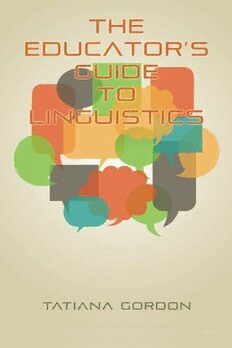
The Educator's Guide to Linguistics: A Textbook for Language Teachers PDF
Preview The Educator's Guide to Linguistics: A Textbook for Language Teachers
The Educator’s Guide to Linguistics The Educator’s Guide to Linguistics Tatiana Gordon Hofstra University INFORMATION AGE PUBLISHING, INC. Charlotte, NC • www.infoagepub.com Library of Congress Cataloging-in-Publication Data Gordon, Tatiana, 1956- The educator’s guide to linguistics / Tatiana Gordon. p. cm. Includes bibliographical references. ISBN 978-1-61735-880-7 (pbk.) -- ISBN 978-1-61735-881-4 -- ISBN 978-1-61735-882-1 (e-book) 1. Linguistics--Study and teaching--Textbooks. 2. Language and languages--Study and teaching--Textbooks. I. Title. P53.412.G66 2012 410--dc23 2012020190 Copyright © 2012 Information Age Publishing Inc. All rights reserved. No part of this publication may be reproduced, stored in a retrieval system, or transmitted, in any form or by any means, electronic, mechanical, photocopying, microfilming, recording or otherwise, without written permission from the publisher. Printed in the United States of America Contents Preface ...........................................................................................ix 1 The Uniqueness of Language .........................................................1 Semiotic Properties of Language ....................................................1 The Language Instinct .....................................................................6 The Critical Period Hypothesis .......................................................6 Universal Grammar Hypothesis ......................................................8 Nicaraguan Sign Language and the Creolization of Pidgins .......9 The Origins of Language ...............................................................11 Implications for Instruction ...........................................................12 Words to Remember .......................................................................12 Notes ................................................................................................13 2 Speech Sounds ...............................................................................15 Phonetics and Phonology ...............................................................15 Initiation, Articulation, and Voicing .............................................16 Consonants ......................................................................................17 Vowels ..............................................................................................19 Pronunciation Challenges ..............................................................21 Phonemes and Allophones .............................................................22 Phonotactics ....................................................................................24 Stress and Rhythm ..........................................................................26 Words to Remember .......................................................................29 Implications for Instruction ...........................................................29 v vi Contents 3 Grammar .......................................................................................33 Morphology .....................................................................................33 Fusion ..............................................................................................36 Agglutination ..................................................................................36 Isolating Languages ........................................................................38 Incorporation ..................................................................................39 Transfix Languages ........................................................................40 Syntax ..............................................................................................41 Descriptive and Prescriptive Grammars .......................................44 Implications for Instruction ...........................................................45 Words to Remember .......................................................................46 Notes ................................................................................................47 4 Semantics ......................................................................................49 Semantic Triangle ...........................................................................49 Gestalt Theory of Meaning ............................................................50 Prototype Effect ..............................................................................52 Conceptual Metaphors ...................................................................54 The Linguistic Relativity Hypothesis ............................................56 Words in Context ............................................................................59 Implications for Instruction ...........................................................61 Words to Remember .......................................................................62 Notes ................................................................................................63 5 Pragmatics ....................................................................................65 Speech Acts .....................................................................................66 Speech-Act Variety Across Languages ...........................................67 Conversational Routines ................................................................70 The Meaning of Speech Acts .........................................................71 Meta-Pragmatic Knowledge ...........................................................72 Pragmatic Competence ..................................................................72 Implications for Instruction ...........................................................75 Words to Remember .......................................................................76 Notes ................................................................................................77 6 Neurolinguistics ............................................................................79 Lateralization and Localization ....................................................80 Contents vii Brain Circuitry in Bilinguals .........................................................84 Co-Speech Gestures .......................................................................85 Mirror Neurons ...............................................................................87 Implications for Instruction ...........................................................88 Words to Remember .......................................................................89 Notes ................................................................................................90 7 First-Language Acquisition ...........................................................93 Early Sounds ....................................................................................94 Early Words .....................................................................................96 Learning Grammar ......................................................................100 The Role of Caretakers .................................................................103 Implications for Instruction .........................................................105 Words to Remember .....................................................................106 Notes ..............................................................................................107 8 Second-Language Acquisition .....................................................109 The Silent Period and the Rejection Period ...............................109 Language Transfer and Contrastive Analysis ..............................110 Creative Construction and Interlanguage ...................................111 Morpheme-Order Studies ............................................................112 Ultimate Attainment ....................................................................113 Linguistic Intuition .......................................................................114 Fossilization ....................................................................................114 Fundamental Difference Hypothesis ..........................................115 L2 Teaching Methodology ...........................................................115 Corrective Feedback and Formal Grammar Instruction ............118 L2 Lexicon.....................................................................................120 Implications for Instruction .........................................................121 Words to Remember .....................................................................122 Notes ..............................................................................................124 9 Language Variation .....................................................................127 Regional and Ethnic Variation: The Example of American English ..............................................................129 Social Variation: The Example of India ......................................132 Social Variation: The Example of American English ................133 Gender Variation: The Example of Japan ..................................134 viii Contents Gender Variation: The Example of American English ..............136 Linguistic Prestige and Accommodation ....................................137 Implications for Instruction .........................................................139 Words to Remember .....................................................................139 Notes ..............................................................................................140 10 Language Planning ......................................................................143 Language Reform: The Example of China ................................144 Linguistic Purism: The Example of France ................................146 Diglossia: The Example of the Arab World ................................147 Language Shift and Language Maintenance: The Example of Mexico ................................................................................148 Language Death: The Example of Australia ..............................150 Language Rights: The Example of the Kurdish Language .......151 Official Language: The Example of American English ............153 Implications for Instruction .........................................................155 Words to Remember .....................................................................156 Notes ..............................................................................................156 11 Language Change ........................................................................159 Old English (OE): Lexicon, Pronunciation, and Grammar ......160 Middle English (ME): Some Lexical and Grammatical Changes ..................................................................................163 Early Modern English (EME): Some Lexical and Pronunciation Changes ..................................................................................167 Attitudes Toward Language Change ...........................................169 Modern English: A Global Lingua Franca ..................................171 Implications for Instruction .........................................................173 Words to Remember .....................................................................173 Notes ...............................................................................................174 About the Author .........................................................................177 Preface When a linguistics professor mentions her job, she is likely to hear some- thing like the following: “You teach linguistics? I took Linguistics 101. Those sentence trees were awful.” Even language education students of- ten find linguistic theory abstract and hard to understand. Unfortunate- ly, this means that linguistic findings that have the potential to transform classroom practice often remain untapped by practitioners. This book is an attempt to address this issue. It was conceived as an instructional tool for teachers and education students, one that would provide them with an accessible overview of linguistic research and explicitly discuss its instruc- tional significance. Many chapters in the book begin with the question, “Have you ever noticed that . . . ?” Such references to the reader’s own language experi- ence are strategic. Starting with the familiar—the staple of effective teach- ing—makes the subject less intimidating and ensures that readers develop a firm and lasting grasp of new ideas. In the same vein, the book illustrates theoretical concepts with language samples (such as popular song lyrics or famous sayings) that are likely to be familiar to the reader. Ultimately, the use of such recognizable language material is intended to help students see the language in their own environment as worth observing and analyzing. “Arbitrariness,” “allophones,” “agreement.” Novices tend to struggle with these and a number of other concepts. Accordingly, this book uses pedagogical tools such as analogies, word-form analyses, and graphics to clarify their meaning. In a number of instances, the text tells the story of The Educator’s Guide to Linguistics, pages ix–x Copyright © 2012 by Information Age Publishing All rights of reproduction in any form reserved. ix
